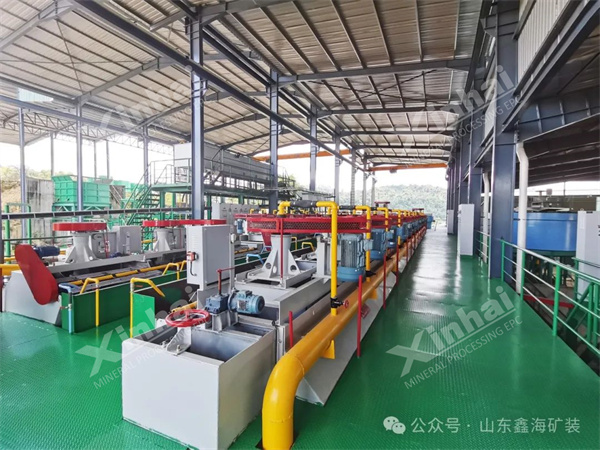Approximately 30% of global lead-zinc deposits are associated with high levels of iron-bearing minerals (such as hematite and goethite). The presence of iron not only lowers the grade of lead and zinc concentrates but also interferes with the flotation process, leading to reduced recovery rates. Economically and efficiently separating iron from lead and zinc minerals is a core challenge in mineral processing design.
(a) Mineral Composition
Lead and Zinc Minerals: Mainly galena (PbS) and sphalerite (ZnS), often associated with pyrite (FeS₂) and pyrrhotite (Fe₁₋ₓS).
Iron Minerals: Hematite (Fe₂O₃), goethite (FeO(OH)·nH₂O), magnetite (Fe₃O₄), etc., often occur as disseminations or veinlets within the lead and zinc minerals.
(b) Chemical Composition Analysis
Typical Content: Lead (1.5%~3.5%), Zinc (3%~6%), Iron (15%~30%), with a positive correlation between iron content and lead/zinc content.
Associated Elements: Silver, copper, cadmium, etc., can be comprehensively utilized, while harmful elements such as arsenic and antimony require targeted suppression.
(c) Ore Structure and Texture
Crystallization Particle Size: Lead and zinc minerals are often intergrown with medium to fine grains (0.05~0.5mm), while iron minerals are often found as micro-fine particles (<0.02mm) coating or adhering to the surface of lead and zinc minerals.
Texture Types: Massive ores require fine grinding for liberation, while disseminated ores require enhanced separation and enrichment.
(a) Crushing and Grinding
Coarse Crushing: Jaw crushers (crushing ratio 3~5) are used to produce particles<150mm.
Fine Crushing: Cone crushers (crushing ratio 4~6), combined with high-pressure grinding rolls (HPGR) to achieve "more crushing, less grinding," reducing energy consumption.
Grinding: Ball mills in closed-circuit with hydrocyclones, controlling the grinding fineness to -0.074mm accounting for 75%~85%, ensuring monomer dissociation of lead and zinc minerals.
(b) Magnetic Separation Pretreatment
Weak Magnetic Separation: Magnetic separators (magnetic field strength 0.1~0.3T) remove magnetite and pyrrhotite, achieving an iron removal rate of 60%~80%.
Strong Magnetic Separation: High-gradient magnetic separators (magnetic field strength 1.0~1.5T) treat non-magnetic hematite and goethite, reducing subsequent flotation reagent consumption.
(c) Flotation Process
Reagent Scheme:
Collectors: Ethyl xanthate (for preferential lead flotation) + xanthate (for zinc flotation), selectively adsorbing onto the surface of target minerals.
Modifiers: Lime (pH 8~9 to suppress pyrite), zinc sulfate (to suppress sphalerite).
Frother: MIBC (methyl isobutyl carbinol) to generate a stable froth layer.
Process Design:
Preferential Flotation: Lead first, then zinc, suitable for ores with coarse mineral intergrowth and low iron interference.
Bulk Flotation: Lead and zinc are first floated together in bulk, followed by separation, which can reduce the entrainment rate of iron minerals.
(d) Gravity Separation Auxiliary
Jigging: Recovers coarse-grained lead and zinc minerals (+0.1mm), reducing over-grinding losses.
Shaking Tables: Treats fine-grained size fractions (-0.074mm), achieving an enrichment ratio of 5~10 times.

(a) Interference of Iron Minerals in Flotation
Problem: Iron minerals generate Fe³⁺ ions after oxidation, which consume collectors and contaminate the froth layer.
Solutions:
Add EDTA or citric acid to complex Fe³⁺.
Use stage flotation, first desliming and then separating.
(b) Fine-Grained Mineral Recovery
Technical Means:
Microbubble Flotation: Using air bubbles with a diameter of<50μm to enhance mineral collision probability.
Selective Flocculation: Adding polyacrylamide (PAM) to flocculate fine-grained lead and zinc minerals.
(c) Polymetallic Separation Challenges
Differential Flotation: Separating galena and sphalerite by adjusting the potential (Eh value -100~+200mV).
Combined Process: Flotation-magnetic separation-gravity separation combined process to comprehensively recover lead, zinc, and iron concentrates.
(a) A High-Iron Lead-Zinc Mine Processing Plant in China
Ore Properties: Lead 2.8%, Zinc 4.2%, Iron 22%, hematite accounts for 35%.
Process Flowsheet: Crushing - magnetic separation pretreatment - lead preferential flotation - zinc flotation - tailings gravity separation to recover iron.
Indicators: Lead concentrate grade 62% (recovery rate 88%), zinc concentrate grade 51% (recovery rate 82%), iron concentrate grade 58% (recovery rate 45%).
(b) Foreign Experience Learning
A Mine in Australia: Uses electrochemical flotation technology to increase lead and zinc recovery by 5%~8%.
Inspiration: Strengthen automatic control (such as online XRF analyzers to adjust reagent dosages in real-time).
(a) New Reagent Development
Environmentally Friendly Collectors: Bio-based xanthates (extracted from plants), reducing toxicity by 70%.
Composite Modifiers: Nano-SiO₂ and organic inhibitors work synergistically to improve selectivity.
(b) Intelligent Mineral Processing Technology
AI Optimization: Machine learning models predict flotation indicators and dynamically adjust grinding fineness and reagent dosages.
Digital Twins: 3D modeling simulates the entire process, shortening the process debugging cycle.
(c) Comprehensive Resource Utilization
Tailings Recovery: Extracting hematite from magnetic separation tailings to prepare iron red pigments, increasing the added value by 30%.
Wastewater Treatment: Membrane separation technology achieves a beneficiation water recycling rate >90%.
The beneficiation of lead-zinc ores with high iron content requires a combination of magnetic separation pretreatment, differential flotation, and multi-process synergy. In the future, the application of intelligent control and environmentally friendly reagents can further improve resource utilization. Innovation in beneficiation technology is not only the key for enterprises to reduce costs and increase efficiency but also the only way to achieve green mining goals.